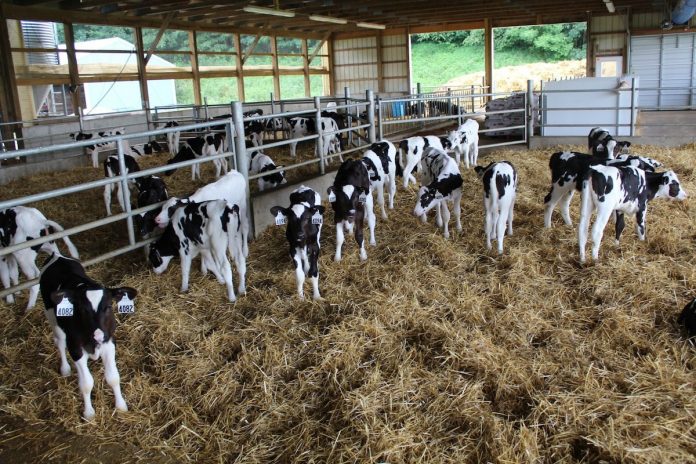It always seems like winter sneaks up before we are ready for it every year. The fans are still hanging in the barn doors when they need shut, and the calf jackets are stuck in the back of the barn, impossible to reach.
So when do we need to start preparing our calf barn for winter? The thermoneutral zone for calves is 50-68 F, meaning when temperatures in their environment are below the lower critical temperature of 50 F, they need extra energy to stay warm.
This can be a challenge since 50 F at night often has highs of 70 F during the day.
Usually, calves deep bedded with straw manage this variation by nesting with their legs covered at least to the middle of the back leg when lying down. The next step is adding calf jackets to help keep calves warm.
Studies show that calf jackets improve gain by 0.22 pounds per day compared to those without jackets. Adding jackets when it is warm out may cause the calves to sweat under the jacket and get chills at night.
Regulating temperature
If you have a calf born prematurely, putting the jacket on at night and off during the day is extra work but may help calves who cannot regulate temperature very well. Calf jacket material should be breathable with a water-resistant shell.
It is recommended that producers start using jackets once pen temperature averages less than 50 F for newborn calves up to three weeks old. Once calves are over 3 weeks of age, they are comfortable until average pen temperatures are below 40 F.
The lower critical temperature continues to decrease as the calf’s rumen develops, creating heat to keep them warm. One important management step with calf jackets is to keep the jackets dry, which means calves should be dry before putting jackets on.
If the calf is still damp, you will need to change jackets after a few hours. In order to put jackets on dry calves, you should have clean towels to dry the calves.
Drying the calf
One thing that works very well when calving barn temperatures fall below freezing, or even 40 F, is to have towels in a cabinet in the calving pen to help the cow dry the calf quickly.
When calves are first born and they start shivering, they are burning precious energy. For each degree drop in temperature below the lower critical temperature, a calf needs a one percent increase in energy to meet maintenance requirements.
There are many different calf-feeding programs. With all programs to continue growth, more milk solids have to be fed without solids concentration exceeding 16 percent. The most common way to increase energy intake is to feed either more per feeding or add a third feeding.
While eight hours apart is ideal for three feedings, the most important part is to make timing consistent. Feed the same amount at each feeding, even if that means adding a lunch feeding between your normal feeding times.
Another beneficial practice is to provide warm water at 63-82 F to calves within 30 minutes of finishing their milk. Water intake improves starter intake by 31 percent.
However, it lowers their rumen temperature requiring energy to warm the water and even more energy to maintain weight and allow for growth.
Fresh air
Close attention needs to be paid to winter ventilation. Keeping barns or hutches warm is not really the goal. Keeping air fresh to minimize disease while not allowing a draft on the calves is the goal.
There are many ways to do this. With hutches, it usually means having either permanent winter wind breaks or temporary wind breaks, like straw bales. Winter winds seem to change and bring cold nasty weather out of every direction, even the south.
In calf barns, pens are a microenvironment affected by ventilation and pen design. Studies have found that solid sides slow disease spread but are only beneficial if the front, back, and top of the pens are open, otherwise, they create a high disease microenvironment.
When disease and ventilation is challenging your calves, a properly designed positive pressure tube providing ventilation at a rate of 15 cubic feet/calf/minute can improve calf health without creating a chill.










